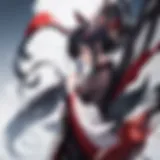A Deep Dive into Ghost Hunter Anime Culture
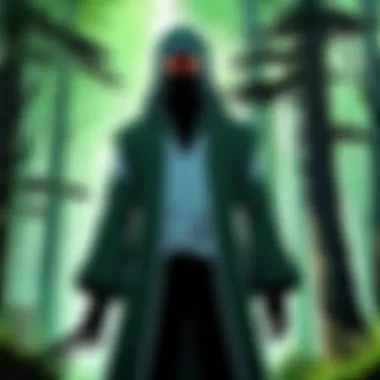

Intro
The world of anime is a vast expanse, rich with diverse genres and captivating narratives. Among these, ghost hunter animecarves out a niche that entices viewers with its blend of the supernatural, psychological intrigue, and cultural elements. In this realm, stories intertwine with folklore and arcane mysteries, resulting in tales that are both thrilling and thought-provoking.
Often, these narratives push characters into confrontations with both external supernatural forces and their own inner demons, creating a layered experience that appeals to a wide audience. This article will dive deeply into the key elements of ghost hunter anime, examining its thematic scope, character journeys, and the pivotal role it plays in cultural discourse. By taking a closer look at specific series—along with their character development and the broader implications of ghost hunting—we aim to provide a holistic overview of this unique genre.
The narrative density of ghost hunter anime serves to mirror complexities we face in our own lives. Themes of loss, redemption, and the morality of our choices resonate strongly in these stories, urging viewers to contemplate the nature of existence beyond the material world. Equip yourself as we embark on this exploration to understand the significant undercurrents that define ghost hunter anime, and how these narratives persistently evolve to reflect contemporary issues in society.
Foreword to Ghost Hunter Anime
Ghost hunter anime, a niche yet fascinating subgenre, strips away the conventional perception of horror and combines it with profound storytelling layers. This genre captivates viewers, offering a glimpse into the delicate balance between the supernatural and human emotions. In this introduction, we will discuss the importance of understanding ghost hunter anime and how it reflects deeper thematic elements that resonate with audiences.
Viewing ghost hunter anime is not just about thrills and chills. The genre often probes into the themes of fear, courage, and the personal battles of the characters navigating through the haunted landscapes of their stories. This aspect elevates its significance, showcasing how animators weave the intimate struggles against fears within supernatural contexts.
The genre serves as a mirror to human nature, exploring the tenuous relationship between the living and the dead. It delves into profound questions about life, death, and what lies beyond, engaging the audience on an emotional level. Whether it's the thrill of chasing ghosts or the quiet moments of reflection, ghost hunter anime provides viewers with an enriching experience. Each episode invites questions about morality, ethics, and the consequences of ghost hunting, rendering the genre not only entertaining but philosophically engaging.
Moreover, ghost hunter anime reveals cultural nuances, deeply rooted in Japanese folklore, which can endear viewers to its narrative even further. The strong connection to local myths provides context and depth, fostering a unique storytelling environment that keeps the genre fresh and thought-provoking.
In upcoming sections, we’ll explore how this genre has evolved, its historical background, and its key themes. Our journey will unveil the varied character archetypes and notable series that have set benchmarks in ghost hunter anime.
"Ghost hunting isn’t merely about the excitement; it’s also about uncovering truths about ourselves and the world around us."
Defining the Genre
Ghost hunter anime can be defined as a crossover of supernatural horror and adventure, where characters embark on quests that often lead them to confront spectral beings or explore haunted terrains. These narratives can range from dark, eerie tales to ones infused with humor and levity. The core of the genre lies in the complexity of the characters and their recourse towards understanding the intangible—whether it be through fear of the unknown or the ethereal curiosity that drives them forward.
Storylines typically revolve around protagonists who may not initially seek to engage with the supernatural; rather, they are often thrust into situations requiring them to confront haunting realities. This genre thrives on the blend of personal growth against the backdrop of ghostly encounters, often leading to cathartic releases and self-discovery. The definition expands as more series emerge, adding diverse layers of narrative and character complexity, pushing boundaries on what is considered ghost hunter anime.
Historical Background
A look back at the origins of ghost hunter anime reveals a rich tapestry that weaves together folklore and modern storytelling. Japan has a long-standing tradition of ghost stories, known as Yurei tales, that depict spirits and their interactions with the living. This historical backdrop sets the stage for what would eventually evolve into the ghost hunter genre in anime.
Emerging in the late 20th century, early examples of ghost-focused narratives can be traced to memorable series like "GeGeGe no Kitaro," which introduced audiences to a world populated with ghosts, yōkai, and other supernatural entities. These early works laid the groundwork for more sophisticated explorations of the genre, capturing public fascination with the paranormal.
The advent of the 2000s saw an upsurge in ghost hunter anime, thanks to shifting cultural sentiments and a growing appetite for stories that probe existential themes. Series such as "Ghost Hunt" blended investigative themes with supernatural elements, appealing to a modern audience hungry for complexity in storytelling. As the genre developed further, several works began to explore not just the supernatural but also the darker facets of humanity, weaving tight narratives that often reflect real-world fears and vulnerabilities.
Today, ghost hunter anime is a vibrant genre that continues to grow, attracting avid fans and sparking discussions around its cultural implications and storytelling techniques. From infused folklore narratives to the ethical concerns of ghost hunting, the genre is a promising landscape for both exploration and reflection.
Key Themes in Ghost Hunter Anime
The genre of ghost hunter anime stands on a foundation of key themes that resonate deeply with viewers. These themes are vital not only for the narrative arcs but also for the audience's emotional journey. By tackling fear, courage, and the supernatural, this genre provides both thrills and thought-provoking commentary on human nature and morality. Each theme intertwines with the others, creating a rich tapestry that holds our attention and reflects our innermost thoughts. Below we delve into three central themes that exemplify the depth of ghost hunter anime.
Exploration of Fear and Courage
Ghost hunter anime often examines the dichotomy between fear and courage. This thematic exploration is not merely about facing phantoms or ghouls; it reflects the characters' internal struggles as well. The protagonists typically find themselves challenged by malevolent spirits, but what is compelling is the emotional resonance of their fear.
Take, for example, the series Natsume's Book of Friends. Natsume, a high school student who can see spirits, embodies the essence of fear and courage. While he grapples with the fear of losing his sanity and his desire for normalcy, he also learns to embrace his gift. This juxtaposition prompts viewers to ask themselves what courage truly is—perhaps it's not the absence of fear but rather the willingness to face it.
"Courage is not the absence of fear, but the triumph over it."
The theme of confronting fear readily engages audiences, creating a relatable pathway to understanding one's vulnerabilities. Whether it’s a confrontation with an angry spirit or overcoming past trauma, the emotional weight of these scenarios captivates viewers and encourages personal reflection.
Supernatural Beings and Their Significance
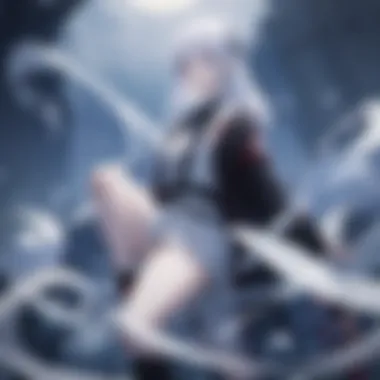

Supernatural beings in ghost hunter anime serve not only as antagonists but also as reflections of the characters’ fears, desires, and cultural beliefs. Each spirit or ghost embodies specific traits and narratives, often deeply rooted in folklore or mythology.
In many cases, the portrayal of supernatural entities is a mirror held up to society, revealing underlying anxieties or societal shortcomings. For example, in the acclaimed series Ayakashi: Samurai Horror Tales, the portrayals of yōkai and other spirits often speak to issues such as isolation and societal pressures. The stories illustrate how these beings not only create fear but also invoke empathy.
Additionally, the significance of these beings can delve into themes of loss and redemption. Characters may seek to resolve the spirits’ unfinished business, connecting the worlds of the living and the dead, highlighting human emotion and connection across different realms and time periods.
Morality and the Ethics of Ghost Hunting
The ethical implications of ghost hunting are prevalent throughout the genre. This theme raises important questions: Are the characters justified in their pursuits? Is it ethical to hunt and capture spirits, or should they instead strive for understanding and cohabitation?
Series like Ghost Hunt tackle these moral quandaries head-on. In this show, the team of ghost hunters often faces dilemmas that force them to weigh personal gain against the potential harm to spirits and their histories. The decision-making process becomes a central narrative driver—each choice can lead to redemption or devastating consequences.
Furthermore, this theme can broaden the conversation about humanity's relationship with the unseen. It addresses cultural beliefs about death and the afterlife, provoking thought about how we honor those who came before us, be they spirit or ancestor. By thoughtfully addressing morality in the pursuit of spirits, ghost hunter anime invites viewers to engage with the material not just as entertainment but as a deeper philosophical exploration.
Character Archetypes in Ghost Hunter Anime
In ghost hunter anime, character archetypes serve as the bedrock of storytelling, providing viewers with characters they can relate to or learn from. Each archetype contributes to the narrative dynamics and enriches the plot, allowing for a more engaging viewing experience. By dissecting these archetypes, we gain insights into character motivations, relationships, and how they navigate the haunted landscapes they inhabit. Here, we spotlight three pivotal archetypes that often emerge in this genre, delineating their roles, functions, and significance.
The Reluctant Protagonist
The reluctant protagonist often embodies the internal struggle between duty and desire. Typically, they begin as individuals unwilling to embrace the ghost-hunting mantle. Maybe they’ve had a traumatic experience involving the supernatural or simply wish to lead a normal life, devoid of the spooky elements surrounding them. This hesitance is not merely for dramatic effect; it resonates deeply with audiences.
Consider Kiriyama from "Ghost Hunt," an example of this archetype. He is initially drawn into the world of ghost hunting through unfortunate circumstances rather than personal inclination. His journey often reflects the audience's fears—what if confronted by the unknown? This archetype adds layers to the storyline, depicting growth as the protagonist navigates both their fear and the ghosts they encounter. Their evolution often showcases personal resilience while underpinning the central theme of facing one's demons, figuratively and literally.
The Eccentric Mentor
In many ghost hunter anime, the eccentric mentor plays a crucial role in guiding the protagonist, often with an unusual style or quirky demeanor. They are seasoned experts of the supernatural realms—wise, knowledgeable, and sometimes a bit wacky. This archetype often serves to balance the story, providing comic relief while offering sage advice at pivotal moments.
Take the character of exorcist Father Fujimoto from "Ayakashi: Samurai Horror Tales." His unconventional methods and quirky personality serve to highlight the absurdity surrounding the ghost-hunting profession, all while imparting wisdom to the less-experienced hunters. The eccentric mentor illuminates a pathway through chaos, showcasing the importance of balance between seriousness and humor. Through their interactions, we often gain a deeper understanding of the lore and intricacies of the supernatural world presented in the narrative.
The Loyal Sidekick
The loyal sidekick is often the unsung hero in ghost hunter anime. They provide unwavering support, whether through emotional backup or aiding in ghost encounters. This archetype symbolizes camaraderie and dedication, often contrasting with the protagonist’s reluctance or eccentricities of the mentor.
For instance, Kenta in "Ghost Stories" exemplifies this type. Kenta is often the glue holding the ghost-hunting group together, offering both practical help and emotional support. His loyalty is pivotal, as it helps validate the protagonist’s struggles against ghosts and their fears. This archetype adds a layer of warmth to the narrative, underscoring the theme that even in the most daunting circumstances, true friendship can illuminate the shadows.
Overall, the interplay between these archetypes not only enriches the narrative but also serves to deepen the thematic explorations present in ghost hunter anime. By examining how these characters interact, audiences can appreciate the complexity of human emotions intertwined with supernatural elements.
Notable Series in the Genre
Ghost hunter anime possess a unique charm that draws audiences into strange, ethereal worlds filled with mystery. By examining specific series within this genre, we gain invaluable insights into the evolution of its themes, character arcs, and visual storytelling techniques. These series often act as cultural artifacts, reflecting the fears, beliefs, and societal values of their time. In essence, they bridge cultural gaps while compelling viewers to confront their notions of the supernatural. Exploring these notable series not only enriches our understanding but allows us to appreciate the artistry behind ghost hunter narratives.
Classic Works and Their Impact
When discussing classic works in ghost hunter anime, titles like Ghost Stories or Natsume's Book of Friends come to mind. Ghost Stories, released in the early 2000s, stands out due to its humorous yet heartfelt narrative. Despite its initially mundane plot, it became infamous for its English dub, which took liberties with the script, creating a cult following. Its irreverent take on ghost hunting encapsulates the blend of humor and horror that often defines the genre.
Natsume's Book of Friends on the other hand, adopts a more dramatic tone. It narrates the story of Takashi Natsume, a boy who can see spirits. This series has left an impactful mark on the medium, reinforcing the idea that ghosts are not merely fearsome entities but also lost souls deserving of empathy. Its gentle approach and stunning visuals have invited audiences to embrace the complexities of human and supernatural relationships.
The impact of these classics extends beyond aesthetics. They have initiated discussions around cultural perceptions of spirits. By portraying ghosts as complex characters, these series challenge viewers to reconsider their preconceptions and engage with the narratives on deeper emotional levels.
Modern Developments and Innovations
In recent years, ghost hunter anime has made significant strides, integrating innovative storytelling techniques and diverse thematic explorations. Shows like Higurashi: When They Cry and Mushishi exemplify this new wave.
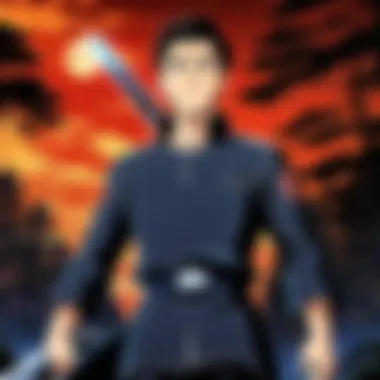

Higurashi blurs the lines between horror and psychological drama, presenting a gripping narrative that explores themes of trauma and memory. Its nonlinear storytelling captivates viewers, making them challenge perceptions of reality. The series effectively employs tension, creating a shocking atmosphere that immerses audiences into its disturbing yet fascinating universe.
Mushishi, on the other hand, takes a more poetic approach to storytelling. It reflects on the relationship between humans and nature, focusing on "Mushi," enigmatic creatures that exist outside normal comprehension. With its serene visual style and contemplative pacing, this series has redefined the ghost hunter subgenre by exploring subtle themes of existence and the unknown. Such innovations breathe new life into ghost hunter narratives, ensuring their relevance in contemporary anime.
Cultural Influences on Ghost Hunter Anime
The realm of ghost hunter anime is intricately woven with various cultural influences that not only shape its narratives but also enrich its thematic depth. Understanding these influences provides insight into how cultural storytelling techniques and traditional beliefs can be transformed into modern-day entertainment. This exploration reveals not just the inspirations behind the stories, but also the evolution of ghost hunter anime as it adapts to contemporary issues while retaining its roots.
Japanese Folklore and Mythology
Japanese folklore and mythology form the backbone of many ghost hunter anime series. These narratives often draw from the vast repository of spirits, demons, and supernatural entities found in classic Japanese texts and oral traditions. For instance, yurei, the spirits of the restless dead, prominently appear in various series, reflecting deep-rooted cultural beliefs about life and death. The eerie whispers from tales like Yotsuya Kaidan, which tells of a vengeful spirit haunting its murderer, resonate through many contemporary works.
Ghost hunter anime often incorporates these mythological figures, breathing new life into them while emphasizing their significance in Japanese culture. The themes of atonement and retribution frequently play out through these characters, underscoring a universal human experience of confronting one's past. For example, in Natsume's Book of Friends, the protagonist interacts with various yuzuki, fusing their tales of sadness and longing into the broader narrative, evoking empathy from viewers.
Moreover, the visual aesthetics used in such anime often mimic traditional Japanese art styles, melding the past with the present. The colors, character designs, and backgrounds sometimes echo the brushstrokes seen in ukiyo-e woodblock prints, creating a unique atmosphere that enchants viewers. This blend serves not just as a narrative device but also as a tribute to the cultural heritage from which these stories have sprung.
Western Adaptations and Hybridization
In contrast, western adaptations and influences on ghost hunter anime present an interesting case of hybridization between cultural storytelling methods. This blending often leads to a unique artistic expression that resonates with diverse audiences. Many anime have taken cues from popular western horror narratives and tropes, turning fear into a shared cultural dialogue.
Take Ghost Stories, for example. Originally a Japanese horror series, it was adapted in America, where it was humorously dubbed and turned into a comedic experience, shifting away from its intended horror atmosphere. This example highlights the influence of western storytelling, where the focus shifted from dread to humor, showcasing how cultural perspectives can reshape content significantly.
Additionally, the fascination with western supernatural mythology, including concepts of ghosts, hauntings, and otherworldly beings, has found its way into Japanese anime. Think of series like The Seven Deadly Sins, where traditional European fantasy elements intertwine with shonen tropes, creating a hybrid format that appeals to both Japanese and international audiences. The incorporation of demonology, often more pronounced in western narratives, expands the thematic landscape of ghost hunter anime.
The Audience's Perspective
Understanding the audience's perspective is essential to the depth and richness of ghost hunter anime. This genre does not exist in a vacuum; it thrives on the interactions and interpretations of its viewers. The audience's reactions to the themes, characters, and narratives shape how these stories are told and evolve. This section delves deeper into two core aspects: viewer symposiums and community engagement, unraveling how fan engagement influences the genre itself.
Viewer Symposiums and Fan Reactions
Anime, especially ghost hunter titles, often sparks passionate discussions among fans. Viewer symposiums serve as a platform for enthusiasts to dissect episodes, share their theories, and engage with the material on a deeper level. These gatherings can range from casual meetups to organized events at anime conventions. Fans express their interpretations of character motivations, plot developments, and the philosophical implications of ghost hunting.
Moreover, social media platforms like Reddit and Facebook become fertile ground for these discussions. Here, fans express their excitement, disappointment, or even confusion regarding specific plot twists or character arcs. For instance, a series like Shiki draws varied opinions on its portrayal of morality and the consequences of supernatural actions. Such robust engagement not only fosters a sense of community but also reveals how diverse the audience's understanding of the genre can be.
"Fan reactions can pivot the narrative direction of a series. Creators often pay attention to how their stories resonate, leading to alterations or developments based on audience input."
Community Engagement and Discussions
Community engagement takes many forms in the world of ghost hunter anime. Online forums buzz with life as fans share artwork, cosplay ideas, and recommendations for similar series. These platforms are more than just discussion boards; they are communal spaces where individuals find common ground over shared interests. It’s not uncommon to see fans forming bonds, leading to offline meet-ups where they can truly immerse themselves in their love for the genre.
Additionally, some fans take it a step further by creating their own content—fan fiction, artwork, or even discussions around the moral dilemmas faced by characters. Mob Psycho 100 and its exploration of supernatural abilities, for example, encourage fans to consider deeper existential themes, prompting discussions that extend beyond just entertainment.
In these animated communities, even the critiques contribute to the ongoing conversation. Fans debate show endings, character development, and the ethical implications of ghost hunting. These discussions infuse the genre with vitality, ensuring it remains relevant and reflective of contemporary societal issues.
Music and Sound Design in Ghost Hunter Anime
Music and sound design in ghost hunter anime play a crucial role in shaping the viewer's emotional experience. Unlike typical animations, where background scores might fade into the background, the right music and sound elements can heighten the tension, evoke fear, and immerse the audience deeply into the supernatural realms.
The auditory palette of ghost hunter anime serves more than just accompaniment; it acts as a character of its own, sculpting the atmosphere. The spine-chilling notes can prepare you for a jump scare or subtly build tension over a longer scene. This relationship between sound and visuals creates a synergy that defines the essence of the genre.
A well-crafted soundtrack can trigger nostalgia, remind viewers of similar experiences, or even set the scene for unsettling encounters with ghosts. Consequently, understanding the design behind these soundscapes isn't just about liking the music; it’s about grasping how it shapes the narrative and emotional weight of the plots.
The Role of Soundscapes
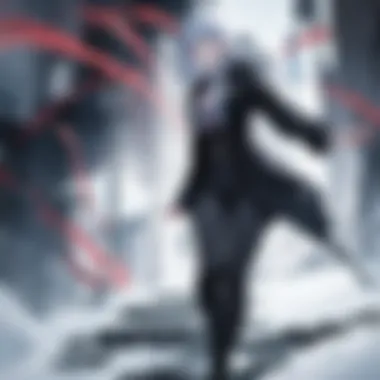

In ghost hunter anime, soundscapes are essential for the storytelling. They represent vast landscapes of sound that envelop the viewer in a specific atmosphere. Whether it's the distant whispers of spirits or the creaking of a haunted house, soundscapes are meticulously designed to prompt a visceral reaction.
Here are a few key roles that soundscapes play:
- Establishing Location: The sound can vividly illustrate a setting, helping the audience feel either the isolating calm of an abandoned shrine or the lingering dread of a graveyard at night.
- Enhancing Emotional Impact: Darker tones and suspenseful crescendos intensify feelings of fear, allowing viewers to experience the characters’ dread and curiosity.
- Building Tension: Gradual layering of sounds can create suspense, resulting in a palpable anticipation of what is to come.
These elements contribute significantly to the story, guiding the viewer’s emotions through the audio journey.
Composers and Their Contributions
Composers in the realm of ghost hunter anime hold a significant position, as the music they create becomes inseparable from the viewing experience. Each composer brings their unique flair, ultimately influencing how stories are told.
For instance, Yuki Kajiura is known for her ethereal soundscapes that blend operatic voices with traditional instrumentation. Such an approach can turn even the most ordinary scenes into haunting spectacles. Likewise, Hiroshi Kamikura, who has worked on several iconic franchises, knows how to inject a sense of foreboding in his compositions, often using minimalistic sounds that resonate with the theme of isolation and fear.
Here’s what to look for when discussing composers in this genre:
- Style: Each composer has a signature style that can either complement or contrast the visual elements, leading to diverse emotional responses.
- Cohesion with the Narrative: The music should align with plot developments, enhancing pivotal moments, whether a horrifying encounter or an emotional character revelation.
- Cultural Influences: Traditional Japanese instruments may be used in one series while another opts for contemporary sound design, illustrating how varied musical approaches can be.
In summary, music and sound design in ghost hunter anime are indispensable for crafting a deeply immersive experience. They pave the way for profound emotional engagement and can turn a chilling story into an unforgettable journey.
Visual Aesthetics in Ghost Hunter Anime
Visual aesthetics play a crucial role in creating the atmospheric and immersive qualities that characterize ghost hunter anime. These elements are not merely decoration; they serve to enhance the storytelling experience, drawing viewers deeper into the eerie and often complicated worlds of ghosts and supernatural beings. In this realm, artists and animators experiment with various styles and techniques to evoke emotions that mirror the themes of fear, curiosity, and mystery inherent in the genre.
Artistic Styles and Techniques
Ghost hunter anime showcases a multitude of artistic styles, each contributing uniquely to the visual storytelling. For instance, some series might employ a darker, more grotesque art style to underline the horror aspects, using stark contrasts and shadowy environments to create a palpable sense of fear. On the other hand, whimsical designs could be used for comedic relief or irony, juxtaposing the serious theme of ghost hunting with more lighthearted elements.
- Cel Shading: This technique is often favored for its ability to give characters a distinct, stylized appearance while maintaining visual clarity. It can enhance expressions, making the characters' reactions to supernatural occurrences more impactful.
- Digital Effects: Many modern series utilize CGI effects to create ghostly apparitions. When done well, these effects can give life to otherwise static backgrounds, imparting a sense of depth and otherworldliness.
- Color Palettes: The use of color is strategic; muted tones often suggest a haunting atmosphere, while splashes of desperate color might punctuate moments of action or fear. This thoughtfulness in color usage enriches the narrative, painting emotions beyond just dialogue.
These techniques, whether subtle or overt, effectively draw the audience into the experience. They help set the mood, hinting at the dangers lurking just beyond sight, especially in series that put heavy emphasis on suspense.
Symbolism in Visual Storytelling
Beyond aesthetics, symbolism plays a vital role in the visual narratives found in ghost hunter anime. The imagery used often communicates deeper meanings, resonating with viewers on various levels. Ghosts, as they are portrayed, frequently symbolize unresolved past, the weight of tradition, or the specter of trauma.
- Ghostly Figures: The appearance of spectral forms often signals more than just fear; it can represent the burden of history or societal issues coming to the surface. By addressing such themes, creators incite viewers to reflect on their relationship with the themes presented.
- Nature Elements: Many series interweave natural symbols—like rainstorms or decaying landscapes—to signify decay or emotional turmoil. These visuals serve as metaphors for the internal struggles of characters, adding layers to their development and interactions.
- Architecture: The setting itself can become a character, encapsulating the isolation or connection tied to the supernatural occurrences. Derelict buildings or ancient temples evoke a sense of time passage, reminding viewers of the weight carried by stories within.
"The use of visual symbolism turns something as simple as a ghost encounter into a commentary on the human experience. It’s about more than chills; it’s about the stories we inherit and pass on."
Future Directions of the Genre
The exploration of future directions in ghost hunter anime is quite significant. As we stand at the crossroads of technological advancement and changing cultural nuances, the genre is ripe for transformation. This evolution can enhance how stories are told and how audiences engage with supernatural narratives. The potential for growth includes reimagining traditional structures and fusing genres to create something fresh and exciting.
Potential Innovations in Narrative Structure
In terms of narrative structure, ghost hunter anime has always leaned heavily on an episodic format. However, there’s a growing appetite for more intricate, serialized storytelling. Rather than presenting standalone episodes, creators might weave overarching plotlines that build suspense and character development across multiple episodes or seasons. Here are some potential innovations:
- Character-driven narratives: Instead of focusing solely on ghost hunting, integrating personal backstories can allow viewers to connect emotionally with characters. This could deepen their investment in the protagonist's journey, enhancing the tension when faced with supernatural challenges.
- Non-linear storytelling: Experimenting with time and perspective can open the door to unique viewing experiences. For instance, flashbacks or alternate timelines may enrich the narrative, enabling viewers to piece together the mystery just as characters are doing.
- Interactivity: With the rise of technology, incorporating interactive elements, such as viewer choices that impact the storyline, could redefine how audiences engage with the content. Imagine fans voting on character decisions or outcomes while following the series.
Cross-Cultural Collaborations
Ghost hunter anime has long drawn influences from various cultures, but a future trend may be in deeper cross-cultural collaborations. As global audiences grow, there is a chance to blend storytelling techniques from different countries, fostering a richer narrative tapestry. Here are some considerations for these collaborations:
- Global themes: Different cultures have unique perspectives on the supernatural. By incorporating these beliefs into ghost hunter anime, creators can introduce diverse storylines and themes that resonate on a broader scale. This could mean borrowing folklore or mythical beings from different societies and integrating them seamlessly into the narrative.
- Diverse creative teams: Collaborations between anime studios and international creators can encourage diverse artistic styles and storytelling techniques. This fusion may lead to innovative animation techniques, creating visually captivating experiences that enhance the storytelling of ghost hunting.
- Expanded audiences: By bridging cultural gaps, ghost hunter anime can attract a wider audience, appealing to fans who appreciate both traditional Japanese folklore and universal themes of fear and courage. This approach could also result in a more nuanced portrayal of ghost hunting, moving beyond the typical tropes.
The blending of cultures and creative talents holds the potential to transform the ghost hunter anime genre into a richer, more global narrative experience, capturing the imagination of a diverse audience while retaining its unique identity.
In summary, the future direction of ghost hunter anime is not merely about evolution but also about enhancement. By pushing the boundaries of narrative structures and embracing cross-cultural collaborations, the genre can attract new fans and reinvigorate its longstanding audience. This opens a world of possibilities that can breathe renewed life into ghost hunting stories, making them relevant for generations to come.
